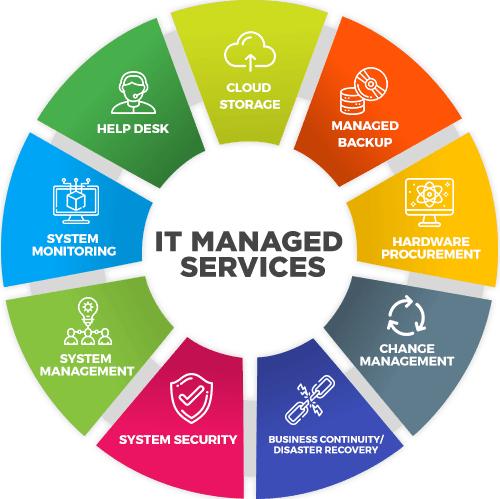The Comprehensive Overview to Understanding Managed IT Providers and Their Function in Streamlining Business Workflow
These services incorporate a spectrum of IT operates, from cybersecurity to information management, each made to ease the concern on internal resources. As companies navigate the complexities of contemporary technology, the calculated application of these services can lead to significant benefits.

What Are Managed IT Providers?
Managed IT solutions refer to the practice of outsourcing the duty for maintaining and anticipating the requirement for a series of IT features and solutions. This version enables organizations to concentrate on their core company goals while entrusting IT administration to specialized carriers (Managed IT). Managed IT services incorporate various offerings, consisting of network management, cybersecurity, information backup and recuperation, cloud solutions, and help workdesk support
By employing a positive method, managed provider (MSPs) display and manage IT systems continually, determining potential problems before they interrupt business operations. This precautionary strategy decreases downtime and boosts system performance. MSPAA. Furthermore, MSPs utilize the most current innovations and finest methods, making sure that companies benefit from advanced services without the need for substantial resources financial investment
The handled IT services model is particularly beneficial for tiny to medium-sized business (SMEs), which may do not have the sources or experience to maintain an internal IT department. By leveraging the abilities and expertise of outside specialists, organizations can guarantee their IT framework is robust, secure, and with the ability of supporting future growth. Inevitably, handled IT services offer as a tactical partnership that straightens modern technology with service goals.
Trick Benefits of Managed IT Provider

In addition, handled IT services offer access to a group of professionals outfitted with the most recent expertise and skills. This makes sure that organizations stay ahead of technical innovations and cybersecurity risks. With 24/7 monitoring and support, businesses can lessen downtime and swiftly address problems, therefore enhancing efficiency.
Scalability is an additional crucial benefit. Handled IT solutions can quickly adapt to a company's development, enabling seamless assimilation of brand-new innovations and processes. This adaptability makes it possible for businesses to react to market adjustments quickly.
Additionally, compliance and risk monitoring are dramatically boosted through managed services, as companies often have durable structures in position to meet industry regulations. Eventually, these advantages finish in a much more safe, reliable, and competitive company, positioning them for long-lasting success in a significantly electronic landscape.
Sorts Of Managed IT Services
Organizations can select from a variety of managed IT services tailored to meet their specific needs and goals. One widespread type is Managed Network Providers, that includes monitoring and managing network efficiency, making certain safety and security, and optimizing connection. This solution is crucial for preserving smooth communication and data transmission within an organization.
An additional crucial offering is Managed Protection Providers. This consists of detailed services such as firewall monitoring, invasion detection, and vulnerability evaluations to protect delicate information against cyber hazards. Given the enhancing frequency of cyberattacks, this solution has actually become important.
Managed Cloud Provider facilitate the migration, administration, and upkeep of cloud frameworks (Managed Cybersecurity). Companies can utilize scalable resources while making certain data integrity and conformity with laws
Managed Aid Desk Provider provide technological support for end-users, solving IT concerns efficiently to reduce downtime and improve performance.
Lastly, Handled Back-up and Calamity Recovery solutions guarantee that essential data is consistently backed up and can be swiftly restored view in instance of information loss cases. By understanding these diverse types of managed IT solutions, organizations can make informed decisions that align with their operational techniques.

Choosing the Right Supplier
Picking the appropriate supplier for managed IT solutions is a critical action in maximizing a company's modern technology method. The selection procedure must start with a clear understanding of your company's details demands and objectives. Recognize the areas where you need assistance, whether it's cybersecurity, cloud services, or network administration, to ensure that prospective companies can fulfill those demands.
Next, assess the supplier's competence and experience in your industry. A provider skilled in your market will certainly understand the special obstacles and conformity needs you face. Additionally, consider their credibility; client testimonies and instance researches can provide insight into their dependability and efficiency.
It's additionally crucial to analyze the scalability of their solutions. As your company grows, your IT requires may evolve, and your service provider ought to be able to adjust appropriately.
Carrying Out Managed IT Provider
Carrying out managed IT services needs a strategic technique to flawlessly integrate these solutions into existing service operations. The initial step includes analyzing the existing IT landscape and recognizing certain needs and obstacles. This clearness enables companies to tailor managed solutions that address their distinct demands.
Next, companies need to develop clear objectives and crucial efficiency indications (KPIs) to measure the efficiency of the handled solutions - Managed IT services. This might include metrics connected to system uptime, reaction times, and user fulfillment. Involving stakeholders throughout the company is critical to make certain buy-in and assist in a smooth shift
Reliable interaction with the selected handled solution supplier (MSP) is also vital. Establishing assumptions regarding solution levels, feedback protocols, and escalation treatments aids promote a collective partnership. In addition, training workers on new systems and procedures ensures they are equipped to leverage the benefits of handled IT solutions.
Conclusion
Finally, managed IT services represent a critical approach to enhancing company operations by contracting out crucial IT functions. These services assist in boosted performance, cost savings, and constant assistance while enabling companies to concentrate on core objectives. By successfully leveraging the proficiency of Managed Expert, organizations can navigate the complexities of modern technology, guaranteeing robust cybersecurity, reputable information monitoring, and optimum system performance. The adoption of handled IT solutions is thus critical in achieving long-term success in a competitive landscape.